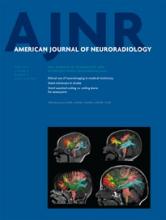Research ArticlePediatric Neuroimaging
Open Access
Role of Diffusion Tensor Imaging as an Independent Predictor of Cognitive and Language Development in Extremely Low-Birth-Weight Infants
U. Pogribna, K. Burson, R.E. Lasky, P.A. Narayana, P.W. Evans and N.A. Parikh
American Journal of Neuroradiology April 2014, 35 (4) 790-796; DOI: https://doi.org/10.3174/ajnr.A3725
U. Pogribna
aFrom the Division of Neonatology (U.P., K.B., R.E.L., P.W.E., N.A.P.)
K. Burson
aFrom the Division of Neonatology (U.P., K.B., R.E.L., P.W.E., N.A.P.)
R.E. Lasky
aFrom the Division of Neonatology (U.P., K.B., R.E.L., P.W.E., N.A.P.)
P.A. Narayana
bDepartment of Pediatrics, and Department of Radiology (P.A.N.), University of Texas Health Science Center, Houston, Texas
P.W. Evans
aFrom the Division of Neonatology (U.P., K.B., R.E.L., P.W.E., N.A.P.)
N.A. Parikh
aFrom the Division of Neonatology (U.P., K.B., R.E.L., P.W.E., N.A.P.)
cCenter for Perinatal Research (N.A.P.), The Research Institute at Nationwide Children's Hospital, Columbus, Ohio
dDepartment of Pediatrics (N.A.P.), Ohio State University College of Medicine, Columbus, Ohio.

References
- 1.↵
- 2.↵
- Laptook AR,
- O'Shea TM,
- Shankaran S,
- et al.
- 3.↵
- Volpe JJ
- 4.↵
- Dyet LE,
- Kennea N,
- Counsell SJ,
- et al
- 5.↵
- Iwata S,
- Nakamura T,
- Hizume E,
- et al
- 6.↵
- Woodward LJ,
- Anderson PJ,
- Austin NC,
- et al
- 7.↵
- Nongena P,
- Ederies A,
- Azzopardi DV,
- et al
- 8.↵
- Ment LR,
- Hintz D,
- Hüppi PS
- 9.↵
- Arzoumanian Y,
- Mirmiran M,
- Barnes PD,
- et al
- 10.↵
- Hüppi PS,
- Dubois J
- 11.↵
- Liu Y,
- Aeby A,
- Baleriaux D,
- et al
- 12.↵
- Rose J,
- Butler EE,
- Lamont LE,
- et al
- 13.↵
- Krishnan ML,
- Dyet LE,
- Boardman JP,
- et al
- 14.↵
- van Kooij BJ,
- de Vries LS,
- Ball G,
- et al
- 15.↵
- Counsell SJ,
- Edwards AD,
- Chew ATM,
- et al
- 16.↵
- Bayley N
- 17.↵
- Jiang H,
- van Zijl PC,
- Kim J,
- et al
- 18.↵
- Anjari M,
- Srinivasan L,
- Allsop JM,
- et al
- 19.↵
- Boardman JP,
- Craven C,
- Valappil S,
- et al
- 20.↵
- Moore T,
- Johnson S,
- Haider S,
- et al
- 21.↵
- 22.↵
- 23.↵
- Eikenes L,
- Lohaugen GC,
- Brubakk AM,
- et al
- 24.↵
- Partridge SC,
- Mukherjee P,
- Henr RG,
- et al
- 25.↵
- Ito M,
- Watanabe H,
- Kawai Y,
- et al
- 26.↵
- Mori S,
- Zhang J
- 27.↵
- Budde MD,
- Kim JH,
- Liang HF,
- et al
- 28.↵
- Gupta RK,
- Hasan KM,
- Trivedi R,
- et al
- 29.↵
- Stadlbauer A,
- Ganslandt O,
- Buslei R,
- et al
- 30.↵
- Concha L,
- Livy DJ,
- Beaulieu C,
- et al
- 31.↵
- Hüppi PS,
- Murphy B,
- Maier SE,
- et al
- 32.↵
- Nagy A,
- Ashburner J,
- Andersson J,
- et al
- 33.↵
- 34.↵
- Pogribna U,
- Yu X,
- Burson K,
- et al
- 35.↵
- Hack M,
- Taylor HG,
- Drotar D,
- et al
In this issue
American Journal of Neuroradiology
Vol. 35, Issue 4
1 Apr 2014
Advertisement
U. Pogribna, K. Burson, R.E. Lasky, P.A. Narayana, P.W. Evans, N.A. Parikh
Role of Diffusion Tensor Imaging as an Independent Predictor of Cognitive and Language Development in Extremely Low-Birth-Weight Infants
American Journal of Neuroradiology Apr 2014, 35 (4) 790-796; DOI: 10.3174/ajnr.A3725
0 Responses
Jump to section
Related Articles
- No related articles found.
Cited By...
This article has not yet been cited by articles in journals that are participating in Crossref Cited-by Linking.
More in this TOC Section
Similar Articles
Advertisement











